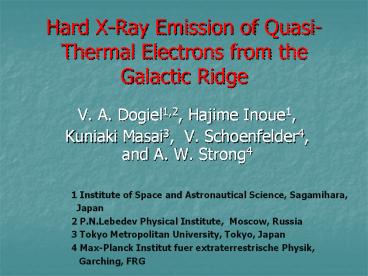Hard%20X-Ray%20Emission%20of%20Quasi-Thermal%20Electrons%20from%20the%20Galactic%20Ridge - PowerPoint PPT Presentation
Title:
Hard%20X-Ray%20Emission%20of%20Quasi-Thermal%20Electrons%20from%20the%20Galactic%20Ridge
Description:
Hard X-Ray Emission of Quasi-Thermal Electrons from the Galactic Ridge V. A. Dogiel1,2, Hajime Inoue1, Kuniaki Masai3, V. Schoenfelder4, and A. W. Strong4 – PowerPoint PPT presentation
Number of Views:107
Avg rating:3.0/5.0
Title: Hard%20X-Ray%20Emission%20of%20Quasi-Thermal%20Electrons%20from%20the%20Galactic%20Ridge
1
Hard X-Ray Emission of Quasi-Thermal Electrons
from the Galactic Ridge
- V. A. Dogiel1,2, Hajime Inoue1,
- Kuniaki Masai3, V. Schoenfelder4, and A. W.
Strong4
1 Institute of Space and Astronautical Science,
Sagamihara, Japan 2 P.N.Lebedev
Physical Institute, Moscow, Russia 3 Tokyo
Metropolitan University, Tokyo, Japan 4
Max-Planck Institut fuer extraterrestrische
Physik, Garching, FRG
2
Galactic Ridge X-Ray Emission
- 30 years since its discovery (Bleach et al.,
1970), but the origin has not been resolved yet. - The total energy flux in the range 2-10 keV is
Qx1038erg/s - Distribution llt50o, blt10o.
3
Origin of the Ridge X-Ray Flux
- Discrete sources. Galactic point-like sources
with required properties are not found from the
ASCA and CHANDRA observations. Excluded.
- Inverse Compton Scattering. Inconsistent with the
observed Galactic radio emission. Excluded.
- Thermal bremsstrahlung origin. X-ray emission
from hot plasma with the temperature 5-10 keV.
Too high rate of SN explosions. Excluded. - The ridge emission is truly diffuse and
nonthermal.
- Nonthermal bremsstrahlung radiation of
subrelativistic electrons or protons. Q1042-43
erg/sgt QSN.
A new class unseen of CR
sources? (or exluded).
4
Thermal vs Nonthermal
- Multi-temperature interpretation
- Regions with temperatures 0.75, 1.8 and 10 keV
are needed to reproduce the Ridge spectrum
(Tanaka 2001) - The position of the Fe-line, 6.61 keV corresponds
to a highly ionized hot medium (Kaneda et
al.1997) with the temperature 5-10 keV
10 kev
plasma is unstable!
5
(No Transcript)
6
Thermal vs Nonthermal
The ridge spectrum is reproduced by a
two-temperature plasma (0.6 and 2.8 keV) a hard
flux of nonthermal subrelativistic electrons
(Valinia et al. 2000)
- A flux of 6.4 keV Fe-line has to be generated
by nonthermal electrons. - The energy output of the electrons as high as
1043 erg/s is needed, i.e. more than can be
supplied by SN stars!
7
(No Transcript)
8
Particle Acceleration from Background Plasma
- The large scale association of the hard X-ray
emission with the thermal X-rays implies that
these two components are linked - This leads to the idea that thermal particle in
the hot plasma are accelerated. - The X-ray flux is produced in the regions where
particles are freshly accelerated (Yamasaki et
al. 1997). - There is an extended transition region of
quasi-thermal particles between the energy ranges
of thermal and non-thermal particles (Gurevich,
1960 Fermi acceleration, Bulanov and Dogiel,
1979 shock wave acceleration)!
9
(No Transcript)
10
Bremsstrahlung of Quasi-Thermal Particles
- Equation for accelerated particles
- EltkT/(a/n)0.4 - thermal particles
- EgtkT/(a/n)0.66 - nonthermal particles
- kT/(a/n)0.66gtEgtkT/(a/n)0.4 - quasi-thermal
particles - Bresstrahlung emission of quasi-thermal particles
the ridge X-ray emission?
11
(No Transcript)
12
List of Problems has to be Resolved
- Energetical problem
- Problem of plasma hydrostatic stability
- Problem of multi-temperature medium
- Problem of highly ionized medium
- Single X-ray spectrum from different regions of
the Galactic Ridge
13
Multi-Temperature X-Ray Spectra
- Two processes form the particle spectrum
- Coulomb collisions which form the background
spectrum - Stochastic acceleration which forms a
power-law tail of non-thermal particles. - The acceleration violates the equilibrium state
of the background plasma that produces a particle
run-away flux into acceleration region. - Coulomb collisions form an extended transition
region of quasi-thermal particles that mimics the
effect of many temperature distribution.
14
(No Transcript)
15
Energy Output
16
Bremsstrahlung of quasi-thermal electrons
QQx tbr/teQxtbr/ti ti/te
105Qxti/te
Qx1038erg/s
Qlt1042erg/s
Quasi-thermal particles
N Nlt N, ti lt t lt tbr
ti
ti
Fx10-5 N
Fx10-5 N/ti, QN/t
x
x
10 38erg/sltQlt10 43erg/s
x
17
Electrons or protons?
- 10 keV photons are emitted either by a
10 keV electron or
by a 20 MeV proton. - For a 0.3 keV plasma the range of quasi-thermal
electrons 5ltElt50 keV gt50 keV the range of
nonthermal particles. 20 MeV protons are
nonthermal. - Qp1043 erg/s Qelt1042 erg/s !!!
18
electrons
protons
19
Pressure of quasi-thermal particles
Region of X-ray emission of thermal and
quasi-thermal particles
Region of X-ray emission of nonthermal particles
Acceleration region Surrounding
medium
Particle lifetime in acceleration region tth
tbr tbrlt tqthlt ti tnth taccltti
Particle pressure in acceleration region Pth1,
Pqthlt0.3, Pnth0 . Plasma
hydrostatically stable!!!
20
Quasi-Thermal Origin of the Line Emission
- Three components of the electron spectrum
thermal (T0.6 keV),
quasi-thermal, and nonthermal - Thermal component ionization state of iron
nuclei 16 - Nonthermal component - 6.4 keV line
- Quasi-thermal component additional ionization
of Fe nuclei. Result 6.61 keV line emission in
relatively cold plasma!
21
(No Transcript)
22
T0.3 keV
23
(No Transcript)
24
(No Transcript)
25
List of Resolved Problems
- Energetical problem - lt1042 erg/s
- Problem of plasma hydrostatic stability - plasma
temperature TltTgr - Problem of multi-temperature medium Artifact.
Emission of quasi-thermal electrons - Problem of highly ionized medium- Ionization by
quasi-thermal electrons - Single spectrum single process of the electron
spectrum formation
26
Conclusion
- Emitting particles - electrons
- Emitting space regions of particle acceleration
- Parameters of the space T 0.6 - 1 keV
- Energy range of emitting particles
quasi-thermal electron (with E5-50 keV) - Acceleration time necessary to produce the ridge
X-ray flux te6 1012 s - The energy output of the emitting electrons
(1-3) 1041 erg/s































